Early Season Soybean Herbicide Injury
June 10, 2024
Introduction
Early evaluation of soybean plant stands to determine uniformity, vigor and growth is important to help ensure that the crop has high yield potential at harvest. Many factors can affect this vigor and one important cause of poor early growth can be herbicide damage, which is always a risk with herbicide applications. While herbicide injury or stunting can be a cause of poor early development there are other potential causes of this type of stunting or seedling damage that are not associated with an herbicide application, herbicide drift, or carryover from a previous application. These potential causes of seedling damage must be evaluated before a positive identification of herbicide damage can be made.
KEY POINTS - Other causes of early season soybean injury not associated with herbicide injury include:
- Environmental conditions
- Frost
- Sandblasting
- Sun scald
- Cold/wet soils
- Compacted soils
- Soil crusting
- Deep planting depth
- Seedling diseases
- Phytophthora
- Rhizoctonia
- Pythium
- Bacterial leaf blight
- Septoria leaf blight
- Virus
- Fertility/soil pH
- Iron deficiency
- Potassium deficiency
- Insect damage
- Aphid feeding
- Nematode
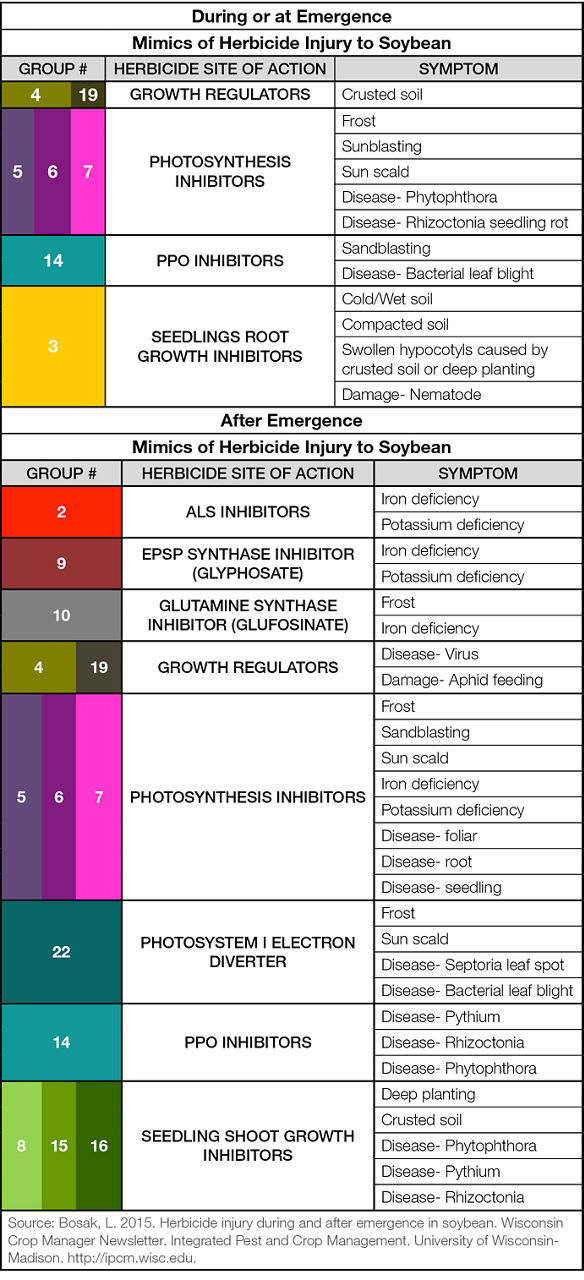
When other causes of early soybean damage or early vigor issues have been eliminated, a basic understanding of the mode of action of the various herbicide groups can help diagnose which herbicide may be causing the symptoms. Each herbicide group has its own symptoms, that when observed, can be critical in diagnosing which herbicide is potentially causing the poor growing characteristics.
Different types of herbicide injury:
- Carryover potential from a previous application, which can be greatly affected by application timing, soil pH, soil type, temperature, and moisture.
- In season herbicide physical spray drift or vapor drift that has moved an herbicide from an off-field application onto the soybean field.
- Using an incorrect herbicide rate, application method, or adjuvants, along with the overlap of an application has caused a 2X or 3X application rate, usually along the field edge.
- Application equipment contamination from poor cleanout procedures.
- Herbicide tank mixtures, including pre-mixtures, can have combined symptoms that can cause more crop injury.
- Poor growing conditions, like extended cool temperatures and wet soil conditions which may reduce the young soybean plant’s ability to metabolize (break down) preemergence herbicides, can increase the potential for soybean injury to labeled herbicide applications.
With the increased incidence of weed resistance across most soybean growing areas, the use of pre-emergence herbicide applications with multiple modes of action, has increased the potential for early season herbicide injury. The trend for early soybean planting has pushed early season soybean growth into environments with cold and wet soil conditions. This type of growing condition slows plant growth which can be a major factor in early season soybean injury, especially when a pre-emergence herbicide program is being utilized.
Identifying which herbicide caused early soybean injury by the symptoms.
Each Herbicide Group (HG) has its own mechanism or mode of action, which has its own set of injury symptoms, which can help identify which herbicide has potentially caused the injury.
Preemergence and Postemergence Herbicides1,2
Seedling root growth inhibitors (HG 3) (examples: pendimethalin, trifluralin): Injury from these herbicides can cause delayed emergence, swelling of the hypocotyl, and reduced root growth. Injury will most likely be observed when the growing conditions are cool along with wet soil conditions which can slow emergence; therefore, reducing the ability of the soybean plant to metabolize the herbicide. Excessive rates of dinitroaniline herbicides may result in seedling soybean plants with pruned roots and swollen or cracked hypocotyls. Occasionally, a preemergence application or shallow incorporation of dinitroaniline herbicides can cause callus tissue to form on the plant stem near the soil surface. This callus tissue that forms on the stem can result in a brittleness which can cause stem breakage or increased susceptibility to lodging.
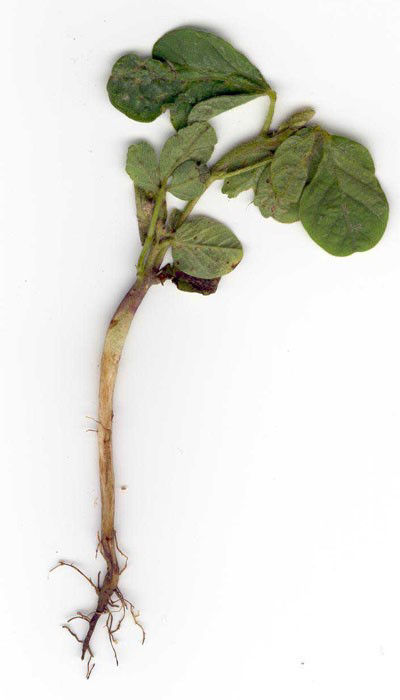
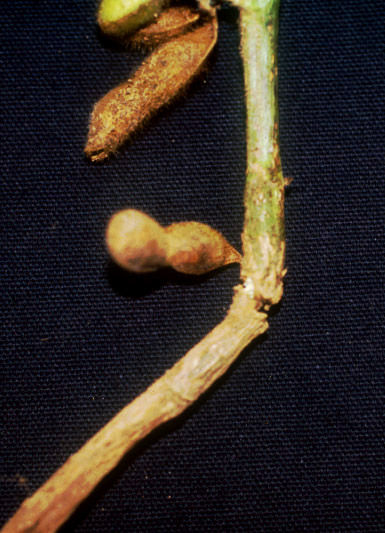
Photosystem II inhibitors (HG 5) (example: metribuzin): Injury symptoms include interveinal chlorosis and necrosis on emerged leaves. These herbicides move in the xylem of the plant and accumulate in expanded leaves. Symptoms typically appear on the unifoliate and first trifoliate leaves. Later-emerging leaves are usually unaffected. If damage is severe, then two or three nodes of leaves may be killed. Soils with high pH can have increased potential for herbicide injury with this chemistry since the herbicide will not break down as quickly which can cause more carryover damage to the next crop.

PPO inhibitors (HG 14) (examples: sulfentrazone, flumioxazin, lactofen): Injury to soybean due to HG 14 herbicide can occur in either preemergence or postemergence applications. Typical preemergence injury can occur as the hypocotyl approaches the soil surface. If heavy rain splashes the herbicide that is on the soil surface onto an emerging soybean plant, it can cause a necrotic lesion to form on the cotyledons or hypocotyl. If these lesions girdle the plant, it can cause plant death. In a season when the early growing environment has sustained cool, wet soil conditions, emerging soybean plants cannot rapidly metabolize the herbicide that is taken up, which can lead to injury. Plant death can also occur when the herbicide encounters the apical bud which may result in malformed leaves. However, in most cases, if a soybean crop can recover quickly, potential yield is not affected by damage. Severe injury is more likely to occur in poorly drained areas of the field. Postemergence injury, specifically during hot and humid weather, appears as a speckling or necrotic tissue on the leaf surface that encounters the herbicide. PPO inhibitors are contact herbicides, and symptoms can be observed on the fully opened leaves at the time of herbicide application. Lactofen herbicide injury to soybean can appear seven to 14 days after application; however, soybean can usually overcome injury symptoms within 21 to 30 days following application without yield loss. Tank contamination and drift can sometimes result in PPO inhibitor herbicide injuries to soybean.
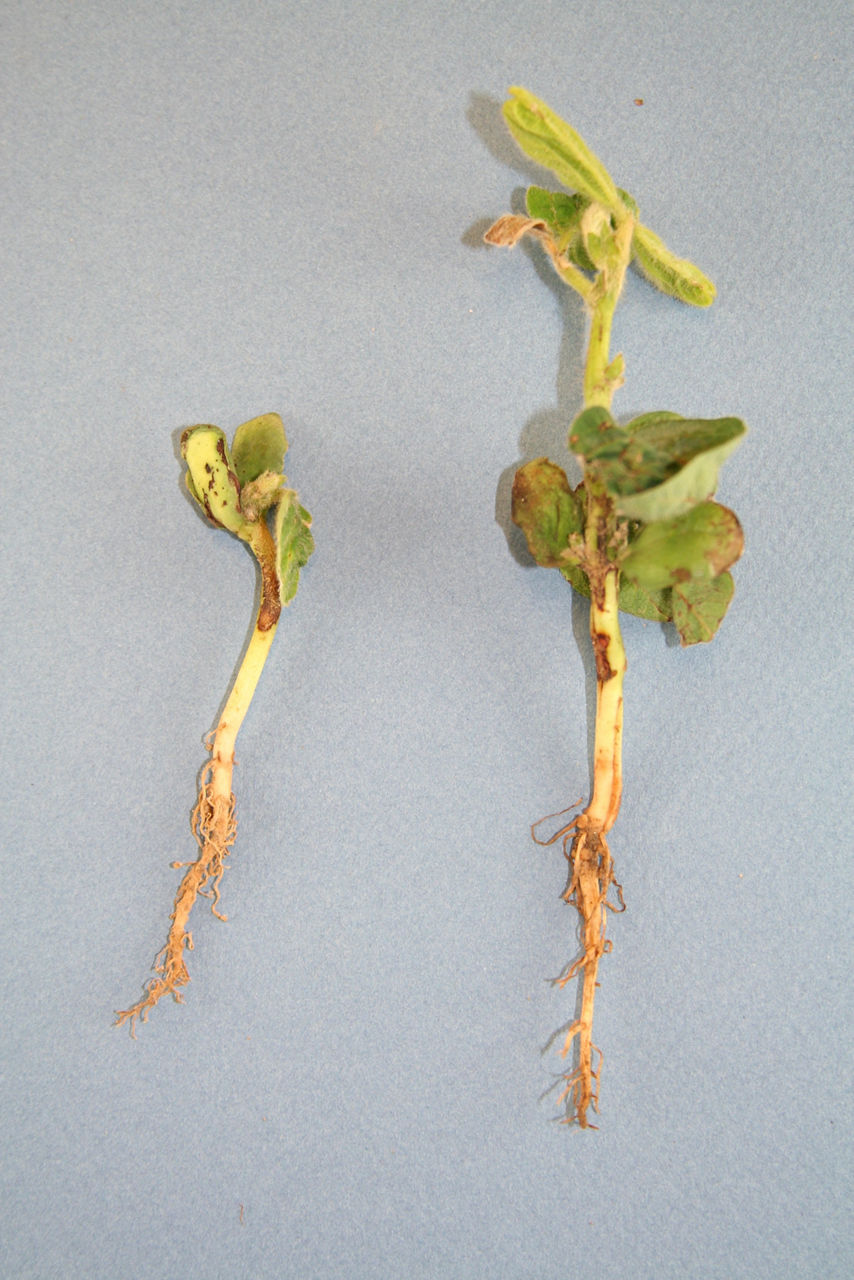

Seedling shoot growth inhibitors (HG 15) (examples: acetochlor, metolachlor, pyroxasulfone): Preemergence and postemergence applications of HG15 herbicides are both labeled for use in soybean and can cause injury to the crop. Herbicides from this site of action group are registered for residual control of grass and small-seeded broadleaf weeds. Cold and wet weather during or immediately following the herbicide application increases the possibility of injury to soybean leaves. Symptoms include shortening of the mid-vein with crinkled and heart-shaped leaves, which may be confused with dicamba injury. Soybean plants typically grow out of this type of injury quickly. If a preemergence herbicide plan includes the combination of a Group 15 products and flumioxazin, this can increase the potential of plant injury due to the interaction of these two herbicides. Fields treated with tank mixes of these products prior to heavy rains may exhibit plant injury due to reduced soybean tolerance.
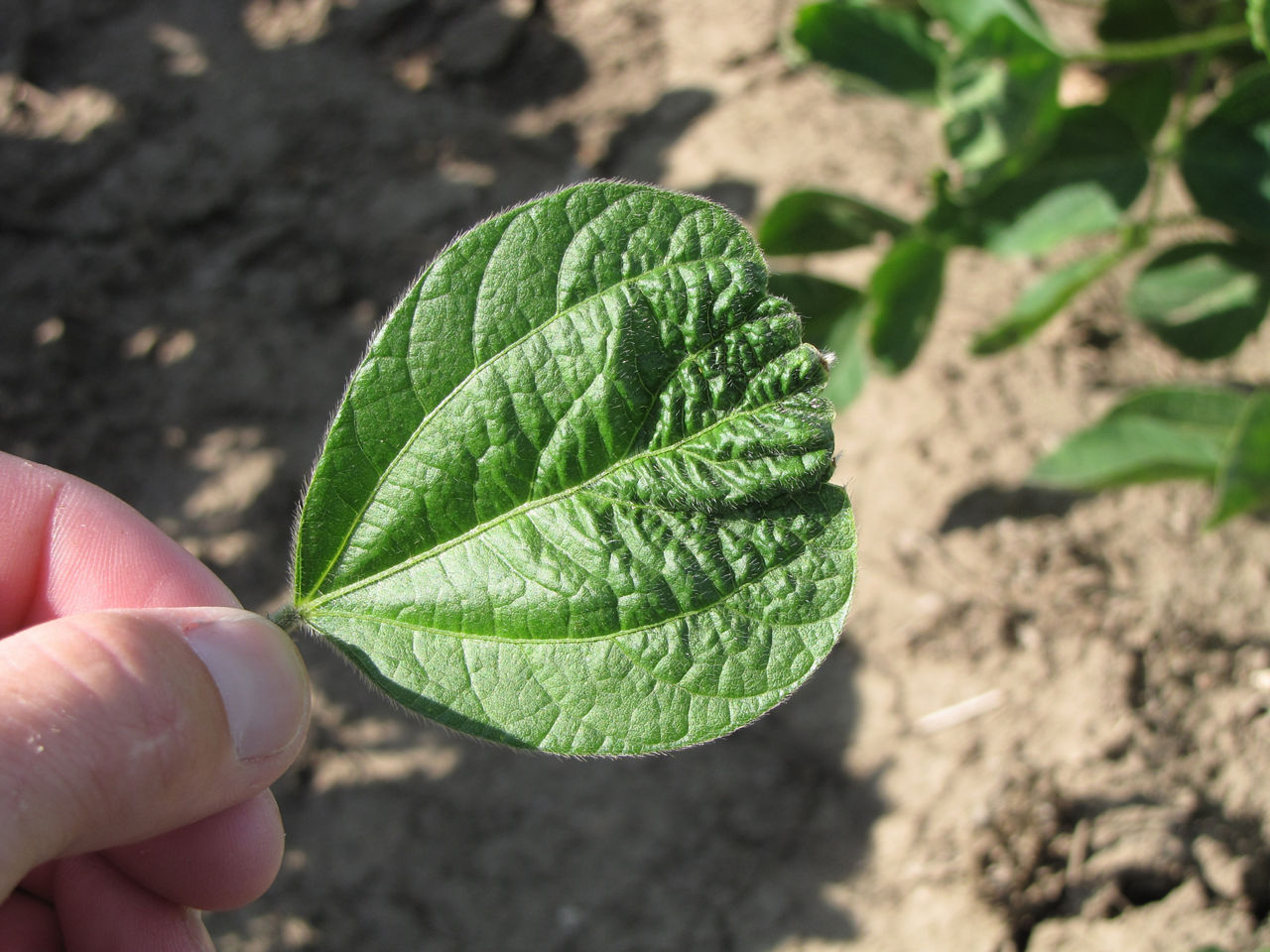
ALS inhibitors (HG 2) (examples: chlorimuron, imazethapyr, thifensulfuron, imazamox): ALS-inhibiting herbicides can be applied to soybean as pre- or postemergence. Soybean plants with injury symptoms from ALS inhibitors may show plant stunting, root stunting, leaf chlorosis and distinctive purpling of leaf veins. Postemergence application injury with these herbicides increases on days with high temperatures and humidity. Due to the systemic activity and movement of an ALS herbicide through the phloem, young leaves are the first to be affected after herbicide application. Soybean plants can typically overcome injury symptoms, without yield loss, from ALS-inhibiting herbicides within several weeks due to rapid growth following injury. However, off-labeled applications can cause plant death.3
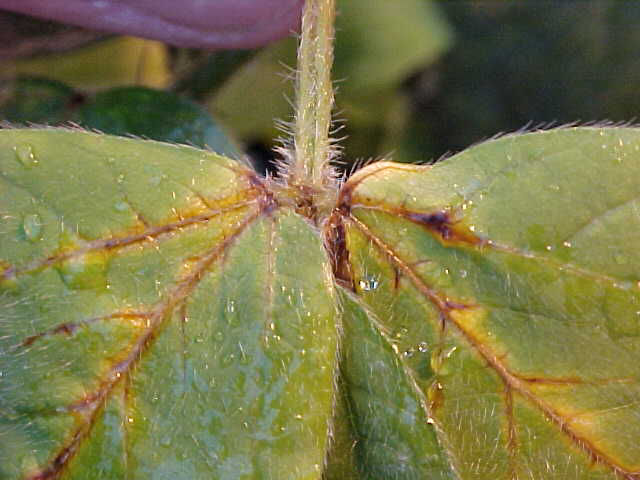
Plant growth regulators (HG 4) (examples: 2,4-D, dicamba): Soybean plants are sensitive to plant growth regulator herbicides if they do not contain herbicide tolerance traits for the specific herbicide being considered. Several herbicides from this site of action group are volatile, and the misapplication or drift of these herbicides may cause injury to sensitive plants, including soybean plants that do not have the specific herbicide tolerance trait for the plant growth regulator herbicide being applied. There are also some HG 4 products that are persistent in the soil, hay, and manure which can cause a carryover injury to soybean. Since these herbicides have systemic activity, soybean injury can be observed on newly developed tissues or leaves. Injury symptoms include epinasty (downward bending or twisting) of the stems and petioles, along with leaf cupping and curling. Leaf shape and venation are often abnormal after exposure to plant growth regulator herbicides, followed by chlorosis of young leaves, and wilting. It may take two to four weeks to kill soybean plants after an application of a plant growth regulator herbicide on a crop without the herbicide tolerant trait.
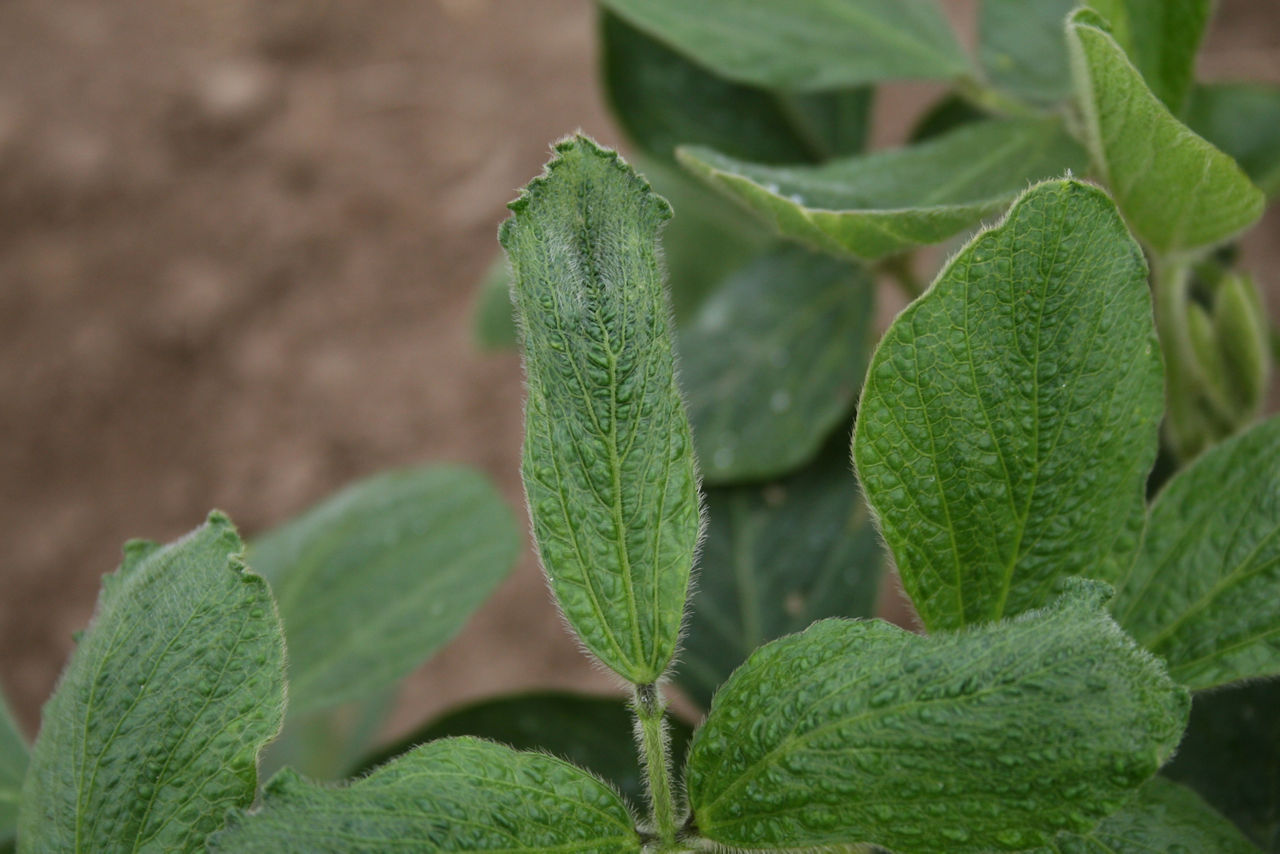
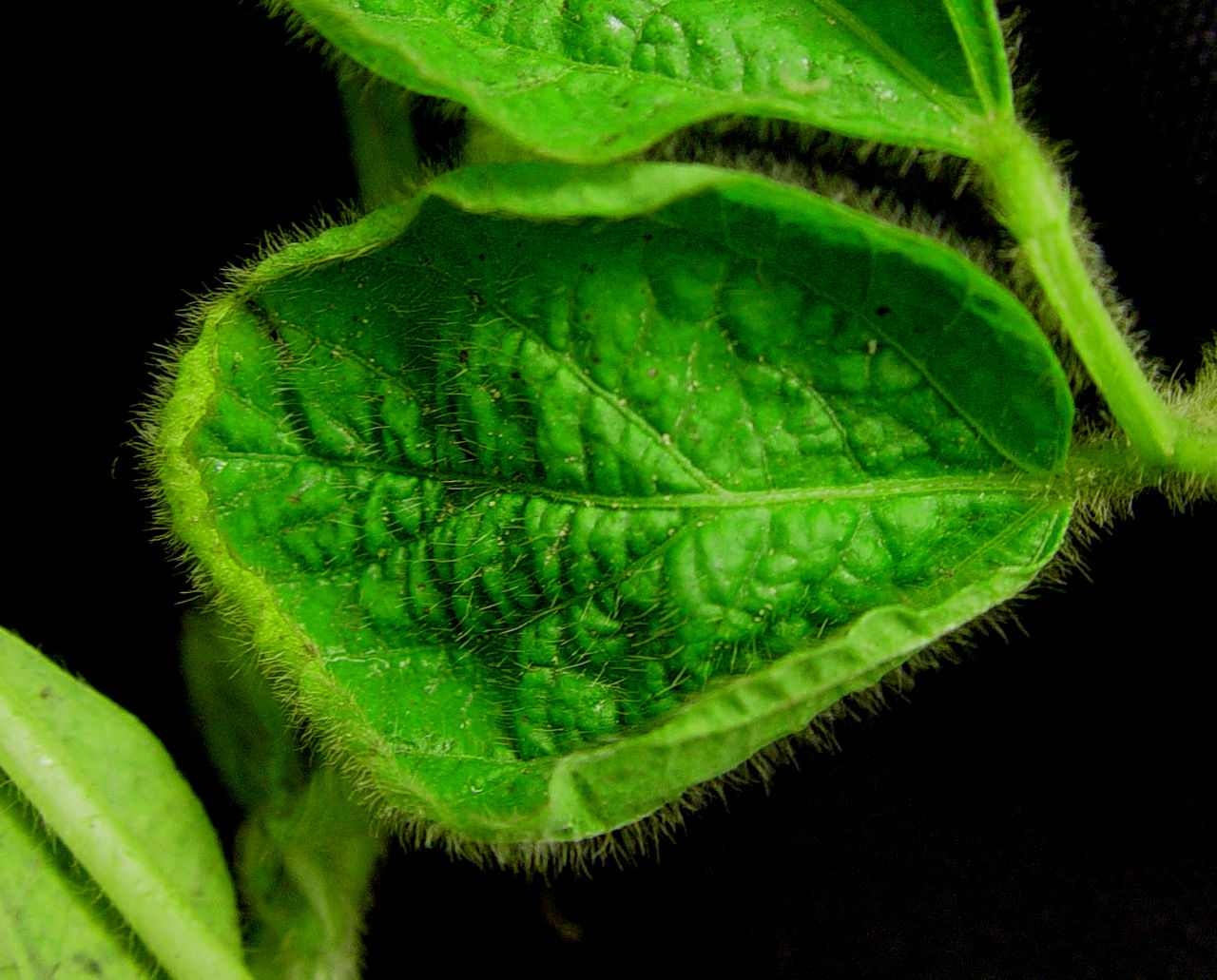
Glutamine synthetase inhibitors (HG 10) (example: glufosinate): Glufosinate can be applied postemergence to a glufosinate-resistant soybean crop. A misapplication of glufosinate on glyphosate-resistant soybean will cause significant injury. Chlorosis and wilting of the soybean plants can be observed within three to five days after application, followed by necrosis in one to two weeks. These symptoms can be observed primarily on older leaf tissue. Bright sunlight, high humidity, and moist soil can increase the intensity of glufosinate injury on soybean plants that are not tolerant to glufosinate.

Management
The risk of injury to a soybean crop following a labeled herbicide application, either pre-emergent or post-emergent, can occur about every year. Most pre-emergence herbicides labeled for application on a soybean crop are either xylem mobile or contact herbicides. Even though these xylem mobile products can move through the plant, only small amounts of herbicide reach the soybean growing point under most growing conditions. With this herbicide modes of action, it is known that in most situations, early damage to a soybean crop is often short term. When good growing conditions such as warm, moist soils return, the crop is expected to recover since these conditions enhance the ability of the crop to metabolize the herbicide and resume normal growth.
One type of plant injury that cannot be ignored is when there is excessive plant stand loss. Multiple plant stand counts should be taken across a field. If the remaining stand is not uniform and is determined to be inadequate for full yield potential, then a replant should be considered. Soybean can compensate for low plant populations by branching out; however, low population stands can have additional issues including more weed pressure.
Herbicide persistence in the soil can be drastically influenced by the weather and the amount of time after application. As a result, crop injury due to herbicide carryover can be an issue. While a soybean crop can be sensitive to herbicides that persist in the soil, this sensitivity is often dependent on the soybean product that is being planted along with soil texture, organic matter, and pH. Other soil factors that can affect the degradation of an herbicide include the herbicide application rate, previous year’s plant growth, timing, rainfall, and temperature. While efforts to predict the carryover potential for any given year and field can be very difficult and expensive, there is one practical method of measuring carryover potential and that is the use of a bioassay. This inexpensive method can be used to measure herbicide carry-over potential and directions on how to perform this test can be found at Bioassay for herbicide residues.4 Confer with your local agronomist or seed professional to assist in assessing carry-over potential for your soybean production acres and any replant decisions that are being considered.
Sources
1Hartzler, B. 2017. Evaluating herbicide injury on soybean. Iowa State University Extension and Outreach. ICM News. https://crops.extension.iastate.edu/cropnews/2017/05/evaluating-herbicide-injury-soybean
2Anderson, M. 2020. Identifying common herbicide symptoms in soybean. Iowa State University Extension and Outreach. Integrated Crop Management. https://crops.extension.iastate.edu/blog/bob-hartzler-meaghan-anderson/identifying-common-herbicide-symptoms-soybean
3 Everman, W. and Jones, E. 2021. ALS-Inhibiting herbicide injury on soybean. North Carolina State Extension Publications. NC State Extension. https://content.ces.ncsu.edu/als-inhibiting-herbicide-injury-on-soybean
4 Neal, J. 2021. Conducting a bioassay for herbicide residues. North Carolina State Extension. NC State Extension Publications. https://content.ces.ncsu.edu/conducting-a-bioassay-for-herbicide-residues
Web sites verified 03/29/2024. 1323_138675